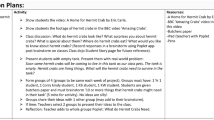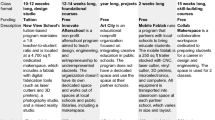Abstract
Making as a design-centered learning activity has recently received significant attention in education. We use literacies—how individuals use representations to learn—to explore the STEM literacy practices of experienced designers and makers. Describing makers’ representational practices in STEM contexts can inform the design of literacy supports for young makers that can encourage their use of representations to connect STEM disciplines and design practices. We interviewed experienced makers to describe one literacy practice central to design: identifying, organizing, and integrating information. Makers enacted this practice within specific making processes—e.g., designing—with the purpose of sourcing and navigating information related to their chosen problems. The research supports efforts to bridge learning while making with learning in schools by positioning STEM literacies as central practices involved in the processes of designing and making.
Similar content being viewed by others
Notes
We do not include analyses of literacies in the other processes (sharing, managing, teaching, and socializing) because the participants in this study tended to discuss their own practices and the ways representations were used in the four processes we focus on in this paper. Many acknowledged the existence of these other processes when considering their work within making spaces, shops, or other community centers with tools.
For an elaborated description of the co-occurrences for all making processes and literacy practices, please see Tucker-Raymond et al. 2017.
References
Barton, D., & Hamilton, M. (1998). Local literacies: A study of reading and writing in one community. London: Routledge.
Bevan, B., Gutwill, J. P., Petrich, M., & Wilkinson, K. (2015). Learning through STEM-rich tinkering: Findings from a jointly negotiated research project taken up in practice. Science Education, 99(1), 98–120.
Blikstein, P. (2013). Digital fabrication and ’making’ in education: The democratization of invention. In J. Walter-Herrmann & C. Büching (Eds.), FabLabs: Of machines, makers and inventors. Bielefeld: Transcript Publishers. (link is external).
Bruna, K. R., & Gomez, K. (Eds.). (2009). The work of language in multicultural classrooms: Talking science, writing science. Routledge.
Burghardt, M. D., & Hacker, M. (2004). Informed design: A contemporary approach to design pedagogy as the core process in technology. The Technology Teacher, 64, 6–8.
Calabrese Barton, A., Tan, E., & Greenberg, D. (2017). The makerspace movement: Sites of possibilities for equitable opportunities to engage underrepresented youth in STEM. Teachers College Record, 119(6), 1–44.
Carley, K. (1990). Content analysis. In R. E. Asher et al. (Eds.), The encyclopedia of language and linguistics (pp. 725–730). Elsmford, NY: Pergamon Press.
Christiaans, H., & Venselaar, K. (2005). Creativity in design engineering and the role of knowledge: Modelling the expert. International Journal of Technology and Design Education, 5, 217–236.
Clandinin, D. J., & Connelly, F. M. (2000). Narrative inquiry: Experience and story in qualitative research. San Francisco: Jossey-Bass.
Coiro, J., & Dobler, E. (2007). Exploring the online reading comprehension strategies used by sixth-grade skilled readers to search for and locate information on the Internet. Reading Research Quarterly, 42, 214–257.
Cole, M. (1998). Cultural psychology: A once and future discipline. Cambridge: Harvard University Press.
Cope, B., & Kalantzis, M. (2000). Multiliteracies. London: Macmillan.
Crismond, D. P., & Adams, R. S. (2012). The informed design teaching and learning matrix. Journal of Engineering Education, 101(4), 738–797.
Cross, N. (1999). Design research: A disciplined conversation. Design Issues, 15(2), 5–10.
Cross, N. (2011). Design thinking: Understanding how designers think and work. Oxford: Berg.
Cross, N., & Cross, A. C. (1998). Expertise in engineering design. Research in Engineering Design, 10, 141–149.
Dym, C. L., Agogino, A. M., Eris, O., Frey, D. D., & Leifer, L. J. (2005). Engineering design thinking, teaching, and learning. Journal of Engineering Education, 94(1), 103–120.
Dyson, A. H., & Genishi, C. (2005). On the case: Approaches to language and literacy research. New York: Teachers College Press.
Fosmire, M., & Radcliffe, D. F. (Eds.). (2013). Integrating information into the engineering design process. West Lafayette: Purdue University Press.
French, M. (1999). Conceptual design for engineers. London: Springer.
Gee, J. P. (1996). Social linguistics and literacies: Ideologies in discourses. London: Routledge.
Graneheim, U. H., & Lundman, B. (2004). Qualitative content analysis in nursing research: concepts, procedures and measures to achieve trustworthiness. Nurse Education Today, 24(2), 105–112.
Gravel, B. E., Tucker-Raymond, E., Kohberger, K., & Browne, K. (2015). Literacy practices of experienced makers: Tools for navigating landscapes of possibility. In Proceedings of Fablearn 2015 annual conference, Palo Alto, CA, September 26–27.
Gutwill, J. P., Hido, N., & Sindorf, L. (2015). Research to Practice: Observing learning in tinkering activities. Curator, 58(2), 151–168.
Halverson, E. R. (2013). Digital art making as a representational process. Journal of the Learning Sciences, 22(1), 121–162.
Halverson, E. R., & Sheridan, K. (2014). The maker movement in education. Harvard Educational Review, 84(4), 495–504.
Heath, S. B. (1983). Ways with words: Language, life, and work in communities and classrooms. Cambridge: Cambridge University Press.
Honey, M., & Kanter, D. (2013). Design, make, play: Growing the next generation of STEM innovators. New York: Routledge.
Hynes, M. M., & Hynes, W. J. (2017). If you build it, will they come? Student preferences for Makerspace environments in higher education. International Journal of Technology and Design Education. doi:10.1007/s10798-017-9412-5.
John-Steiner, V. (1997). Notebooks of the mind. Explorations of thinking (2nd ed.). Albuquerque: University of New Mexico Press.
Jones, A., Buntting, C., & de Vries, M. J. (2013). The developing field of technology education: A review to look forward. International Journal of Technology and Design Education, 23, 191–212.
Koen, B. V. (1988). Toward a definition of the engineering method. European Journal of Engineering Education, 13(3), 307–315.
Lawson, B. (2006). How designers think: The design process demystified. Amsterdam: Architectural Press.
Lee, V. R., & Fields, D. (2013, October). A clinical interview for assessing student learning in a university-level craft technology course. Paper presented at FabLearn 2013, Stanford University, Palo Alto, CA.
Leu, D.J., Forzani, E., Rhoads, C., Maykel, C., Kennedy, C., & Timbrell, N. (2015). The new literacies of online research and comprehension: Rethinking the reading achievement gap. Reading Research Quarterly, 50(1), 1–23. Newark, DE: International Reading Association. doi:10.1002/rrq.85. Available at: http://www.edweek.org/media/leu%20online%20reading%20study.pdf.
Lewis, T. (2006). Design and inquiry: Bases for an accommodation between science and technology education in the curriculum. Journal of Research on Science Teaching, 43(3), 255–281.
Lincoln, Y. S., & Guba, E. G. (1985). Naturalistic inquiry (Vol. 75). Sage.
Lofland, J., & Lofland, L. H. (1995). Analyzing social settings. Belmont, CA: Wadsworth Publishing Company.
Martin, L. (2015). The promise of the maker movement for education. Journal of Pre-College Engineering Education Research (J-PEER). doi:10.7771/2157-9288.1099.
Martinez, S. L., & Stager, G. (2013). Invent to learn: Making, tinkering, and engineering in the classroom. Torrance: Constructing Modern Knowledge Press.
Miles, M. B., Huberman, A. M., & Saldana, J. (2013). Qualitative data analysis: A methods sourcebook. Incorporated: SAGE Publications.
Moses, R. P., & Cobb, C. E. (2001). Radical equations: Math literacy and civil rights. Boston: Beacon Press.
National Governors Association Center for Best Practices & Council of Chief State School Officers. (2010). Common core state standards. Washington: Authors.
Nemorin, S. (2016). The frustrations of digital fabrication: An auto/ethnographic exploration of 3D ‘Making’ in school. International Journal of Technology and Design Education. doi:10.1007/s10798-016-9366-z.
NGSS Lead States. (2013). Next generation science standards. Accessed: http://www.nextgenscience.org/next-generation-science-standards.
Pahl, G., & Beitz, W. (1995). Engineering design: A systematic approach. London: Springer.
Papert, S., & Harel, I. (Eds.). (1991). Constructionism. Cambridge: MIT Press.
Peppler, K. (2010). Media arts: Arts education for a digital age. Teachers College Record, 112(8), 2118–2153.
Peppler, K., Halverson, E., & Kafai, Y. B. (Eds.). (2016). Makeology: Makerspaces as learning environments (Vol. 1). London: Routledge.
Petrich, M., Wilkinson, K., & Bevan, B. (2013). It looks like fun, but are they really learning? In M. Honey & D. E. Kanter (Eds.), Design, make, play: Growing the next generation of STEM innovators (pp. 50–70). New York: Routledge.
Quintana, M. G. B., Pujol, M. C., & Romaní, J. R. (2012). Internet navigation and information search strategies: how do children are influenced by their participation in an intensive ICT project. International Journal of Technology and Design Education, 22(4), 513–529.
Resnick, M., & Rosenbaum, E. (2013). Designing for tinkerability. In M. Honey & D. E. Kanter (Eds.), Design, make, play: Growing the next generation of STEM innovators (pp. 163–181). New York: Routledge.
Sheridan, K., Halverson, E. R., Litts, B., Brahms, L., Jacobs-Priebe, L., & Owens, T. (2014). Learning in the making: A comparative case study of three makerspaces. Harvard Educational Review, 84(4), 505–531.
Street, B. (2003). What’s “new” in new literacy studies? Critical approaches to literacy in theory and practice. Current Issues in Comparative Education, 5(2), 77–91.
Tate, W. (2001). Science education as a civil right: Urban schools and opportunity-to-learn considerations. Journal of Research in Science Teaching, 38, 1015–1028.
Tucker-Raymond, E., Gravel, B., Wagh, A., & Wilson, N. (2016). Making it social: Considering the purpose of literacy to support participation in making and engineering. Journal of Adult and Adolescent Literacy, 60(2), 207–211.
Tucker-Raymond, E., Gravel, B. E., & Kohberger, K. (2017). Source code and a screwdriver: STEM literacy practices in fabricating activities among experienced adult makers. Journal of Adult and Adolescent Literacy, 60(6), 617–627.
Varelas, M., & Pappas, C. C. (Eds.). (2013). Children's ways with science and literacy: Integrated multimodal enactments in urban elementary classrooms. Routledge.
Vossoughi, S., & Bevan, B. (2014, October). Making and tinkering: A review of the literature (pp. 1–55). National Research Council Committee on Out of School Time STEM. Accessed: http://www.sesp.northwestern.edu/docs/publications/1926024546baba2b73c7.pdf.
Wardrip, P. S., & Brahms, L. (2015). Learning practices of making: developing a framework for design. In Proceedings of the 14th international conference on interaction design and children. New York: ACM.
Wardrip, P. S., & Brahms, L. (2016). Taking making to school. In K. Peppler, E. Halverson & Y. B. Kafai (Eds.), Makeology: Makerspaces as learning environments (Vol. 1, pp. 97–106). Routledge.
Wilson, V., & Harris, M. (2003). Designing the best: A review of effective teaching and learning in design and technology. International Journal of Technology and Design Education, 13, 223–241.
Wilson, A. A., Smith, E., & Householder, D. L. (2014). Using disciplinary literacies to enhance students engineering design activity. Journal of Adolescent and Adult Literacy, 57(8), 676–686.
Acknowledgements
We would like to thank Paula Hooper and Amon Millner for offering thoughtful critiques that pushed our thinking on this work. This material is based upon work supported by the National Science Foundation under Grant Number DRL-1422532. Any opinions, findings, and conclusions or recommendations expressed in this material are those of the author(s) and do not necessarily reflect the views of the National Science Foundation.
Author information
Authors and Affiliations
Corresponding author
Rights and permissions
About this article
Cite this article
Gravel, B.E., Tucker-Raymond, E., Kohberger, K. et al. Navigating worlds of information: STEM literacy practices of experienced makers. Int J Technol Des Educ 28, 921–938 (2018). https://doi.org/10.1007/s10798-017-9422-3
Accepted:
Published:
Issue Date:
DOI: https://doi.org/10.1007/s10798-017-9422-3




